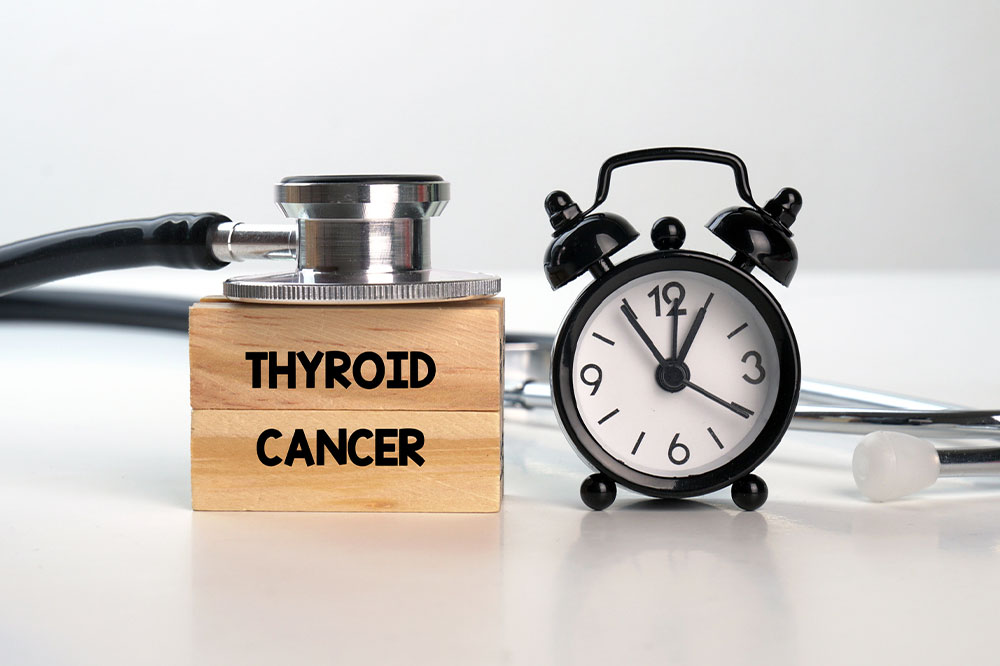
Thyroid Cancer – Causes, Symptoms, and Management
The thyroid is a butterfly-shaped gland located at the base of one’s neck. When this area experiences an abnormal growth of cells, it indicates a health condition known as thyroid cancer. The thyroid gland plays a crucial role in regulating several bodily functions, like the heart rate, body temperature, blood pressure, and body mass. Read further to learn more about thyroid cancer, what causes the condition, its symptoms, and management methods.
Causes
Thyroid cancer develops when the cells mutate, grow, and rapidly multiply. When the healthy cells naturally die after some time, these abnormal cells accumulate and form a mass known as a tumor. This tumor can then grow further and affect other tissues and organs, spreading to the rest of the body. The exact reason behind this is unknown; however, certain risk factors raise one’s odds of developing this condition. A few such trigger factors are listed below.
Genetics
Inheriting genetic syndromes from family members with health conditions like cancer can increase the chance of developing this disease. According to studies, 2 in 10 cases of medullary thyroid cancer are triggered by an abnormal gene inherited by the individual through the family.
Iodine deficiency
While rare, iodine deficiency can be another risk factor in developing certain types of thyroid cancer. However, the risk is minimal since most foods available in the country, canned and home-cooked, has iodine added.
Radiation exposure
If an individual was exposed to any radiation treatment on the head or neck during their childhood, it could increase the increase of developing thyroid cancer.
Symptoms
It is observed that the signs and symptoms of thyroid cancer do not appear in the initial stages and occur only when the tumor grows. Therefore it is important to observe the changes happening in the body to know about any irregularities. Some early warning signs of the condition are listed below.
- Trouble swallowing foods (mainly solid foods)
- Trouble breathing properly
- A persistent cough not triggered by cold
- Swelling/inflammation in the neck
- Pain in the neck at the front, which can get severe and sometimes can be felt in the ears
- Change in voice or hoarseness that does not go away
- Lump in the neck, which grows quickly
These symptoms may seem regular and often overlap with noncancerous diseases. Still, it is advised to get a complete diagnosis done by a health professional to help you understand the root cause of your condition. Usually, the lumps found in the thyroid are benign and common. Still, it is best to get them treated to avoid any risks or complications that can lead to thyroid cancer.
Studies indicate that thyroid cancer is more common in women than in men. Women usually develop this type of cancer in their 40s and 50s. Men are known to develop this type of cancer in their 60s or 70s. However, young people can also risk developing this cancer, so always look for the warning signs and symptoms.
Types of thyroid cancer
Papillary thyroid cancer
It is the most common form of thyroid cancer. 80% of thyroid cancer patients are diagnosed with this form of cancer. It is known to grow slowly but easily spreads to the lymph nodes located in the neck. However, one can manage the symptoms effectively with treatment, and the chances of recovery are high.
Follicular thyroid cancer
It is the second most common type of thyroid cancer that affects 10% to 15% of thyroid patients. Follicular thyroid cancer spreads into the lymph nodes but also has the chance of spreading into the blood vessels.
Medullary cancer
Even though this is an uncommon type of thyroid cancer, it can easily be detected in the initial stage. It is because a hormone called calcitonin is released when medullary cancer starts developing, and doctors can spot this hormone through blood tests.
Anaplastic thyroid cancer
It is the rarest and also hardest type of cancer to treat. The reason is its aggressive nature as it rapidly spreads to nearby tissues and organs, leaving insufficient time for treatment and recovery. Anaplastic thyroid cancer is usually diagnosed among people over 60
Management
Several options for managing thyroid cancer are available, and the chances of successful treatments are very high. The treatment options vary depending on the type of thyroid cancer and what stage it has been diagnosed at. Some of the common thyroid cancer treatments are mentioned below.
Thyroid hormone therapy
It is a treatment used to replace or supplement the hormones produced by the thyroid gland. It can be used after thyroid surgery, where the gland has been removed to prevent the spreading of the tumor; hence the body now requires supplements that will produce the hormones necessary for keeping the body functioning well. Another way to use thyroid hormone therapy is to suppress the growth of the thyroid-stimulating hormone, which causes the cancer cells to grow.
Thyroid cancer surgery
This surgery removes all or most of the thyroid, a portion of the thyroid, or removing lymph nodes in the neck. Depending on where cancer has spread and at the stage of the disease, a healthcare expert makes this decision following a detailed diagnosis.
Other treatment options include radioactive iodine, targeted therapy, chemotherapy, radiation therapy, and heat and cold methods to destroy cancer cells. Post-treatment care is integral to recovery, not just for physical health but also for mental health. It is advised to have a supportive environment with friends and family who can positively contribute to the recovery process. More importantly, being aware of the warning signs and symptoms of the condition is important because thyroid cancer can metastasize and affect other body parts, such as the lungs, liver, or bones. Early detection and management of the condition in its initial stages reduce the risk of the tumor spreading.


